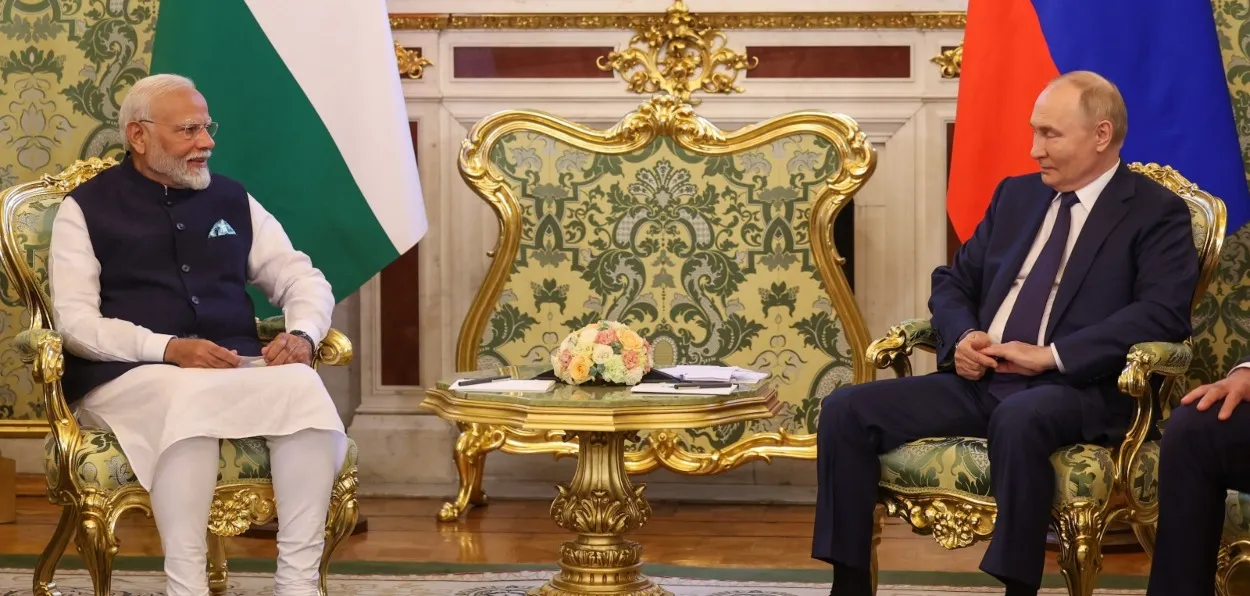 Sushma Ramachandran
Sushma Ramachandran
India and Russia are witnessing a resurgence in the economic relationship after several decades. In recent years, the formerly burgeoning rupee-rouble trade had contracted and became confined to defense purchases. Both countries had also been relying increasingly on Western developed countries for consumer goods as well as heavy equipment and machinery. With the onset of the Ukraine war, this scenario has altered significantly. India has begun buying huge quantities of crude oil from Russia while the latter is now looking to source various products.
News Analysis
The deepening of ties was evident during the latest visit of Prime Minister Narendra Modi to Moscow, the first since the Ukraine conflict began. Though strategic ties were naturally on the agenda, trade and economic issues were the focus of discussions. In this context, it must be noted that bilateral trade rose to 65 billion dollars in the last financial year from merely 12 billion dollars just two years ago. Talks are also on the anvil for bilateral investments and a free trade agreement.
This is the backdrop for the summit-level talks which showed the visible camaraderie between the two leaders. There was some concern over this display of warmth notably by Ukrainian President Volodymyr Zelensky. Still, most Western powers implicitly accept that these longstanding ties are not getting derailed anytime soon.
The visit has ended with several expected outcomes. This includes setting the target for bilateral trade at 100 billion dollars by 2030, developing a bilateral settlement system using national currencies, and launching digital financial instruments. An area of interest for this country has been investing in Russia’s Far East and an agreement on joint projects has been concluded. Yet another issue of significance is the Vladivostok-Chennai corridor which is being considered a vital link for faster growth of both trade and investment in the region. A working group on increasing trade via the Northern Sea Route in the Arctic region is also being set up though this is more relevant for Russia.
One of the highlights of the discussions has naturally been energy cooperation where the exponential rise in crude oil imports since the Ukraine war began is now a given. But an agreement has also been concluded on long-term cooperation in nuclear energy linked to existing plants as well as fresh projects. Bilateral investments are similarly being promoted with Russia reported to be considering getting involved in the manufacturing of ships and railway wagons. India, on the other hand, is looking at upstream exploration plans in the resource-rich Far East.
On the trade front, the major element now is crude oil being bought at discounted prices despite Western sanctions. It has been due to these cheaper purchases that the oil import bill was contained at manageable levels over the last two years. But this also led to a huge expansion in the trade deficit with roughly 60 billion dollars’ worth of imports compared to a paltry few crore of exports. The need to set right this imbalance has been recognised by both sides and discussions on the issue have been continuing since last year.
One option has been to expand the rupee payment route as mentioned in the joint statement regarding the use of national currencies for settlement. Till last year, the effort to extend rupee payment from defense purchases to other areas had become a major irritant between the two countries. Russian Foreign Minister Sergei Lavrov had expressed concern during the G-20 conference over the inability to utilize the roughly eight billion rupees stored in Indian banks These accumulated rupee funds were largely on account of defense acquisitions rather than oil imports which are being paid for in foreign currencies.
This nagging problem was largely resolved during this year, according to recent reports, as the rupee funds have been utilized in various ways. This includes higher exports from India, along with investments in infrastructure projects and the equity markets.
The need to evolve a rupee payment mechanism that is acceptable to both sides is critical, especially in the backdrop of Western sanctions on Russia. With banks reluctant to face strictures from Western financial institutions on this count, shifting to payment via national currency makes eminent sense.
As for Russia, it is now increasingly looking to countries like India and China to source a wide range of goods that were earlier being imported from European or American sources. Investment in the infrastructure sector here also becomes viable in the long run as Western sanctions are not likely to be lifted in the short run. It would thus be possible to move towards rupee-rouble payment systems and this has been reflected in the joint statement.
One issue that has not been touched upon in detail in the talks is the proposed free trade agreement with the Russia-led Eurasian Economic Union (EEU). These negotiations resumed last year after a pause during the pandemic but could improve ties further with Russia as well as other EEU members, Armenia, Kazakhstan, Kyrgyzstan, and Belarus. It was noted, however, that the process of negotiations needs to be expedited in the months ahead.
The Modi-Putin summit has certainly had its strategic aspects especially with the Indian Prime Minister urging Russia to move towards peace talks with Ukraine. Defense ties have also been given a boost with the plan to promote domestic manufacturing of much-needed spare parts. But the agenda has been largely economic with the two countries recognising that mutual self-interest underpins the deepening ties.
It is now clear that these will extend beyond energy cooperation to a wide range of industrial sectors. This includes the digital economy, science and research, and pharmaceuticals as well as high-tech sectors. This shows that India and Russia are taking a mature approach and moving ahead to expand the mutually beneficial relationship despite the pressures imposed by geopolitical frictions.

 Sushma Ramachandran
Sushma Ramachandran